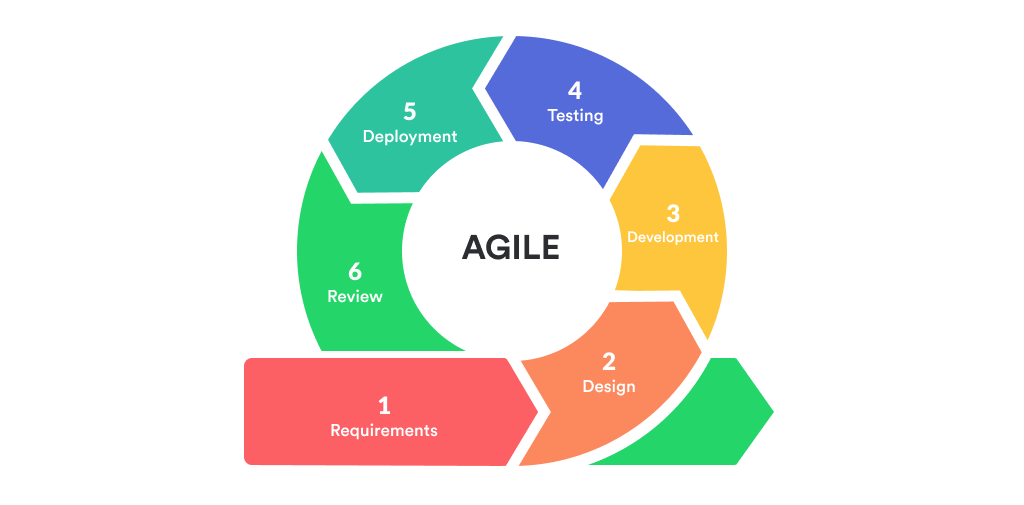Many Software development companies are utilizing Agile methodology in mobile application development, thanks to its diverse applications. Agile methodology principles collaborate with organizations flexibly and adaptively. With a transforming world, the concept of Agile is bringing effective software products to the market.
One of the most particular things about Agile is its emphasis on the nature of work and the way it is being accomplished. The Agile methodology brings solutions that are introduced with a mutual collaboration between self-managing organizations and their cross-functional terms that use the ap test techniques for best outcomes. For development companies of all sizes, the utilization of Agile methodology in mobile application development is playing a significant role in empowering their businesses.
There are many prime subjects to consider in Agile methodology for mobile application development, but organizations using Agile Methodologies for Software Development mainly focus on the collaborative and self-organization of teams with each other. It further helps teams to ensure having an ability to demonstrate the ways to approach things on their own by becoming cross-functional. Generally, these teams do not have any hardly specified roles but the right set of skills.
In this blog, we are going to discuss, what is Agile methodology? And how it can create impacts on the modern application development market and some of its key terms.
What is Agile Methodology?
The agile development methodology is a process through which a team manages an Agile software development project by segregating its process elements in different phases with constant collaboration and engagement of market leaders to improve and iterate things on every stage of development.
The Agile methodology is implemented with customers describing the end-application of the products and the targeted problems to be resolved. After initiating the task, teams go through a process of making a strategy, running the strategy, and then analyze the results. It totally transforms the approach to deliver the final product to the customers and successfully meets their needs.
In an Agile software development company, Agile methodology is identified as a project management process anticipating transformative flexibilities more than conventional techniques being followed for years. Customers can realize small transformations tackling more significant challenges in reduced expenses and time.
The process comprises a prioritization of requirements and their delivery to each individual in the process cycle on time. Each iteration in the process is reviewed and examined by the members of development teams and customers. The results provided after each process segment help to design the next phases of development.

The Agile methodology in mobile application development provides customers with a high-priority of their engagement in the entire development cycle. The primary objective of this methodology is to engage customers in every phase of the process and complete it in the shortest possible time. The methodology efficiently saves the clients’ money and time as customers check and approve a software product in every phase of the development.
For any errors and challenges, changes can be adopted during the product cycles of the products, and everything can be fixed at the moment. Conventional strategies of project management do not serve any particular benefits or advantages as they are not tested so frequently. However, in Agile methodology too, errors are not detected in various phases to get the final product delivered flawlessly and in less time.
Why Use Agile Methodology?
Mobile application development companies have been utilizing the Agile development model to increase their efficiency and quality. Companies using Agile Methodologies for Software Development are leveraging high customer engagement and satisfaction, which provide value to their businesses.
- Stakeholder Engagement
Agile methodology facilitates organizations to leverage plenty of opportunities for stakeholder and team interaction before, during, or even after the completion of development. Faster delivery of applications and frequently enhance the stakeholders’ credibility in an Agile software development company’s capability to fulfil their needs with quality services.
- Transparency
Agile allows customers a unique chance to be engaged in all phases of the product, including the prioritization of features to planning the iteration and reviewing of sessions. Although, it needs customers’ understanding of the work’s progress with included benefits of transparency.
- Early and Predictable Delivery
Since Agile provides customers with a timelined, consistently scheduled sprint of 1 to 4 weeks, it becomes easier to deliver the product with new features in less time with high-level predictability. This also facilitates the opportunity to release a beta version of mobile applications before the launch of the complete version in the space of fair business value.
- Predictable Costs and Schedule
Since every phase is timely scheduled, it becomes simpler to provide a predictable cost of the product. With a precise cost, users can see a detailed estimate of the cost for every single feature included in the applications, their priority, and the need for additional iterations.
- Allowing Change
Development teams are required to emphasize delivering mobile applications with an agreed-to subset of the features while any particular iteration is running. It arises as an opportunity to refine and reprioritize the complete product backlog continually. Any new or updated backlog items can be planned for upcoming iteration with a chance to introduce new developments in a few weeks.
- Emphasis on Users
The agile methodology generally utilizes user stories with business-oriented allowance criteria to demonstrate product features. With an emphasis on features considering users’ requirements, every feature can exceedingly exhibit value, beyond its value as an IT product. It also facilitates mobile application development companies with an opportunity to launch beta test applications just after every sprint, attaining value, feedback in earlier sessions of the product development process with an ability to transform things as per requirements.
How Agile Methodology Has Transformed Mobile App Development
Agile is genuinely considered a powerful asset in the field of mobile app development, which does not only offer significant advantages to the team of developers but also adds value to the businesses of their clients. It facilitates organizations to deal with multiple general project downfall such as cost-related issues, predictability issues, etc. With reorganizing and re-envisioning of different activity engagements in custom app development, organizations gain their business objectives in a more focused way.
Valuing interactions among customers, mobile app developers, and other members help to prioritize standard processes with Agile effortlessly. A project solely handled through a process and proper documentation can lead to many transformative changes that can possibly meet the customers’ requirements in time.
What are the Frameworks Used in Agile Methodology?
Agile features several important frameworks like Scrum, Kanban, Extreme Programming (XP), and Adaptive Project Framework (APF) that can significantly be utilized for effective application development. Scrum has been among the most popular among all. The integration of the Scrum framework in Agile methodology is generally referred to as Agile Scrum Methodology.
What is Agile Scrum Methodology?
Agile Scrum Methodology is one of the most sought Software development methodologies adopted by many prestigious companies in the world like Microsoft, Yahoo, Google, IBM, etc. for different objectives consisting mainly of Agile software development, in-house app development, contract development and also for non-software projects. The Agile Scrum methodology features a process of self-organization of teams and a series generally two weeks, which is termed as ‘Sprints.’
As per the 12th annual State of Agile report, it was stated that about 70% of software teams prefer Scrum or a Scrum hybrid over other frameworks.
Industry leaders are now mulling to collaborate Agile project management techniques on Scrum, more frequently combining them with other framework’s terminologies in the future.
Why Use Agile Scrum Methodology?
There are many significant benefits of Agile Scrum Methodology notably including its encouragement for developing applications faster within any particular sprint’s time frame and increased productivity of software applications.
Here are some other benefits of Agile Scrum Methodology:
- Scrum methodology employs easy documentation
- Errors can simply be detected and rectified
- Clear visibility of the agile project management and development progress
- Iterative in nature and needs regular customer feedback
- Short sprints and regular feedback makes coping with changes simpler
- Individual productivity enhances the results of daily meetings
- Problems are identified in advance and hence can be rectified faster
Deploy the Agile Scrum Methodology for Your Projects
The utilization of Agile methodology in testing or mobile app development has provided app development companies with a significant alternative to conventional methods of project management in the software industry. This practical approach has led to an evolution through which organizations are utilizing a combined effort of development teams and their clients. The terminology has promoted the advent of adaptive strategy, evolutionary development techniques, fast delivery of software products, and regular improvements.
On coming to comprehending the role of Agile technology in the modern-age application development industry, you can take note of mobile app developers leveraging easy and effective development of applications even for the small screen, less memory, and less processing speed devices.
Choosing Your Agile Partner
Success depends on finding teams that truly embrace Agile—whether it’s Atlanta application development specialists for two-week sprints, Chicago’s top mobile firms for scaled Agile frameworks, or a Dallas mobile app company with hybrid methodology experience.









